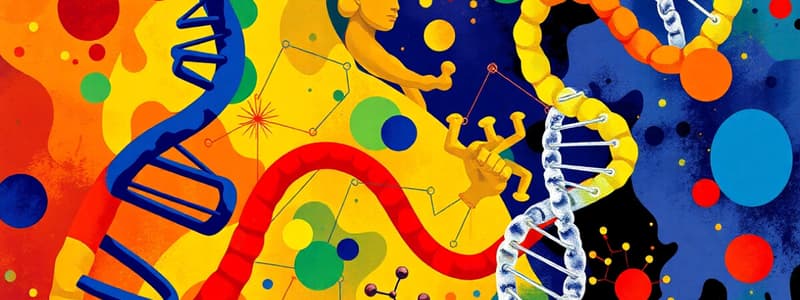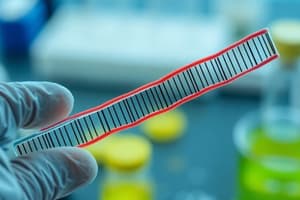Podcast
Questions and Answers
What is one way enzymes lower activation energy?
What is one way enzymes lower activation energy?
- By increasing substrate concentration
- By interfering with enzyme function
- By activating the substrate directly
- By altering bond structures in the substrate (correct)
Enzymes function optimally in any environment without restrictions.
Enzymes function optimally in any environment without restrictions.
False (B)
Name one factor that can alter the rate of enzyme reactions.
Name one factor that can alter the rate of enzyme reactions.
Temperature, pH, or enzyme concentration
Enzymes can facilitate the __________ of electrons to or from a substrate.
Enzymes can facilitate the __________ of electrons to or from a substrate.
Match the following factors to their effect on enzyme activity:
Match the following factors to their effect on enzyme activity:
What are the primary functions of nucleic acids?
What are the primary functions of nucleic acids?
DNA consists of a single strand.
DNA consists of a single strand.
What type of bond connects the base pairs in DNA?
What type of bond connects the base pairs in DNA?
RNA is typically ________________.
RNA is typically ________________.
Match the following components of nucleotides with their descriptions:
Match the following components of nucleotides with their descriptions:
Which of the following pairs are considered complementary base pairs in DNA?
Which of the following pairs are considered complementary base pairs in DNA?
Deoxyribonucleic acid contains ribose sugar.
Deoxyribonucleic acid contains ribose sugar.
Nucleotides are joined by ____________ bonds.
Nucleotides are joined by ____________ bonds.
Which of the following is a difference between RNA and DNA?
Which of the following is a difference between RNA and DNA?
DNA and RNA are made of different types of nucleotides.
DNA and RNA are made of different types of nucleotides.
What are the complementary base pairs for the DNA sequence 5’CCGCAAACCCGCTATGTT3’?
What are the complementary base pairs for the DNA sequence 5’CCGCAAACCCGCTATGTT3’?
The __________ fits precisely in the __________ in order for the reaction to proceed.
The __________ fits precisely in the __________ in order for the reaction to proceed.
Match the following nucleobases to their corresponding pairs in DNA:
Match the following nucleobases to their corresponding pairs in DNA:
What does the 3’ and 5’ indicate in a DNA strand?
What does the 3’ and 5’ indicate in a DNA strand?
Enzymes are consumed during the reactions they catalyze.
Enzymes are consumed during the reactions they catalyze.
What is the induced-fit model in relation to enzymes?
What is the induced-fit model in relation to enzymes?
What occurs when an activator binds to an enzyme?
What occurs when an activator binds to an enzyme?
Non-competitive inhibitors bind to the active site of the enzyme.
Non-competitive inhibitors bind to the active site of the enzyme.
What is the role of the end product in feedback inhibition?
What is the role of the end product in feedback inhibition?
An enzyme's active site changes shape when a __________ binds to it.
An enzyme's active site changes shape when a __________ binds to it.
Match the following terms with their definitions:
Match the following terms with their definitions:
At what temperature is enzyme activity at its peak?
At what temperature is enzyme activity at its peak?
Enzymes are most active at a pH of 2 in the stomach.
Enzymes are most active at a pH of 2 in the stomach.
What happens to enzyme activity at very high temperatures?
What happens to enzyme activity at very high temperatures?
Adding more substrate will eventually cause activity to _____ as the enzyme becomes limiting.
Adding more substrate will eventually cause activity to _____ as the enzyme becomes limiting.
Which of the following factors can activate enzymes?
Which of the following factors can activate enzymes?
Name one type of inhibitor that can regulate enzyme activity.
Name one type of inhibitor that can regulate enzyme activity.
Match the following factors with their effect on enzyme activity:
Match the following factors with their effect on enzyme activity:
What is the initial effect of increasing enzyme concentration on rate of reaction?
What is the initial effect of increasing enzyme concentration on rate of reaction?
Study Notes
Nucleic Acids
- Nucleic acids are polymers made of nucleotide monomers.
- They primarily function as hereditary material (DNA) and play roles in protein synthesis (RNA).
- Nucleotides are composed of a sugar molecule (ribose for RNA, deoxyribose for DNA), a phosphate group, and a nitrogenous base.
- Nitrogenous bases are categorized as purines (Adenine and Guanine) or pyrimidines (Cytosine, Thymine in DNA, and Uracil in RNA).
- DNA is a double helix with two antiparallel strands, held together by hydrogen bonds between complementary base pairs: Adenine pairs with Thymine, and Cytosine pairs with Guanine.
- RNA is typically single-stranded.
Enzymes
- Enzymes are proteins that catalyze (speed up) biological reactions.
- Most enzymes are named after the reaction they catalyze and end in "-ase."
- Enzymes have a specific active site that fits precisely with the substrate, enabling the reaction to proceed.
- The induced-fit model describes how the substrate interacts with the enzyme's active site, leading to a conformational change that weakens bonds in the substrate and accelerates the reaction.
- Enzymes lower activation energy by providing an alternative reaction pathway, facilitating the transfer of electrons or H+ ions to or from the substrate.
- Enzyme activity is influenced by environmental factors such as temperature, pH, enzyme concentration, and substrate concentration.
- Enzyme activity can be regulated by:
- Cofactors/Coenzymes: Activators that bind to the enzyme, inducing a conformational change and increasing activity.
- Competitive Inhibitors: Molecules that resemble the substrate and bind to the active site, preventing the substrate from binding.
- Non-Competitive Inhibitors: Molecules that bind to a site other than the active site, altering the enzyme's shape and disabling its activity.
- Allosteric Changes: Conformational changes induced by activator or inhibitor molecules, affecting the enzyme's activity.
- Feedback Inhibition: A mechanism where the final product of a metabolic pathway acts as an inhibitor to an early enzyme in the pathway, regulating the pathway's activity.
Studying That Suits You
Use AI to generate personalized quizzes and flashcards to suit your learning preferences.
Related Documents
Description
This quiz covers essential concepts in molecular biology, focusing on nucleic acids like DNA and RNA, alongside the role of enzymes in biological reactions. Test your understanding of nucleotide structures, base pairing, and enzyme functionalities. A great way to solidify your knowledge in these fundamental topics!




